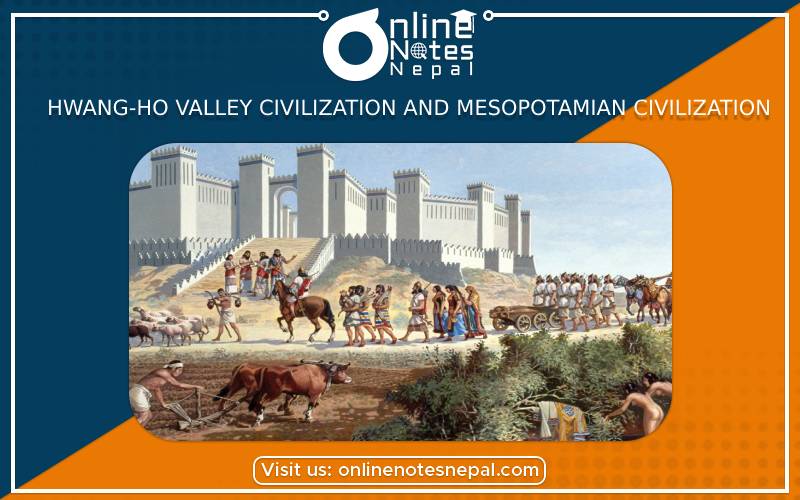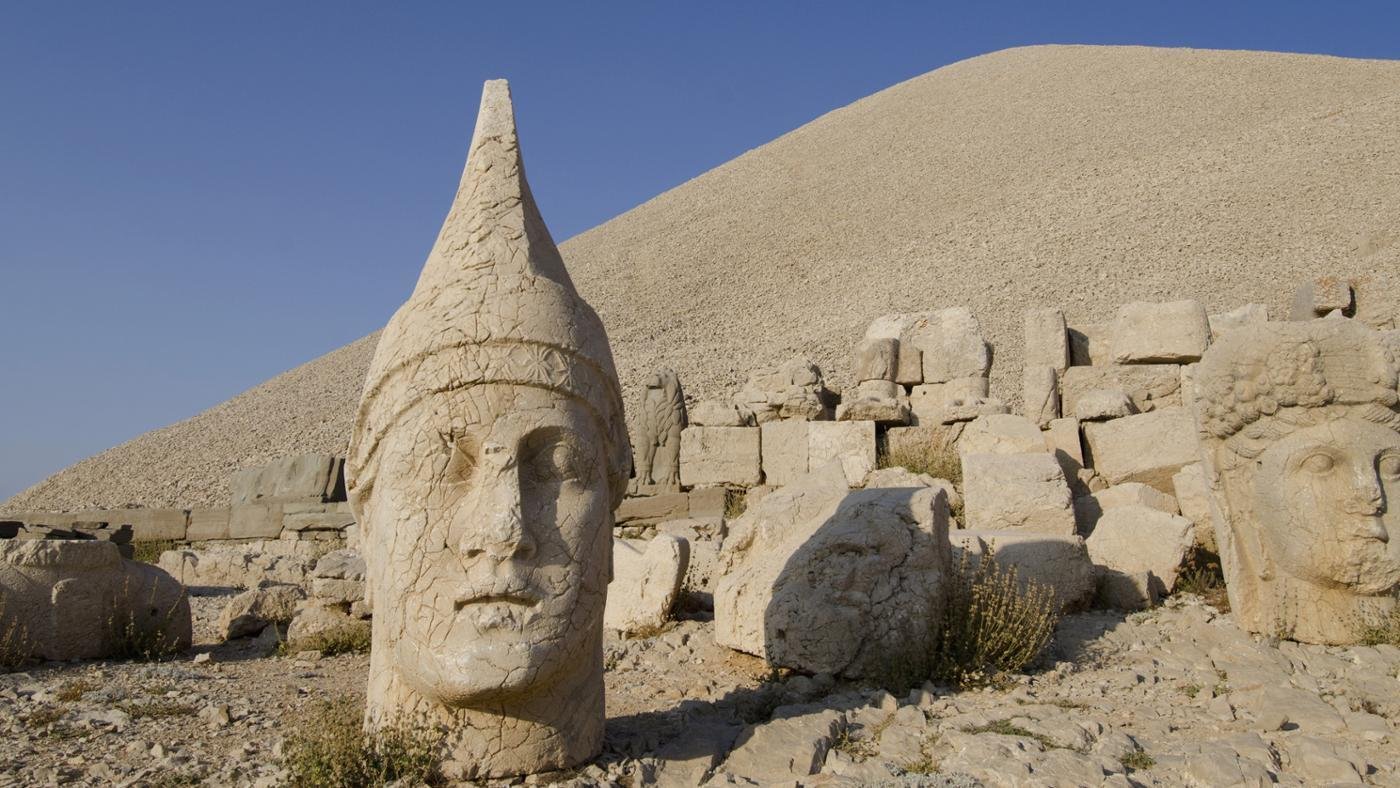Published by: Nuru
Published date: 27 Jan 2022

Hwang-Ho Valley Civilization and Mesopotamian Civilization
Hwang-Ho Valley Civilization and Mesopotamian Civilization are one of the oldest civilizations. Reference notes of Grade 7, Social Studies.
The Hwang-Ho Civilization is one of the important civilizations of the world. It was developed about 3600 to 1600 years ago in Hwang-Ho river valley in China. It is the famous river of China known as Yellow river. The valley was made up of plain fertile soil and held enough moisture for growing crops and for human settlement. Finding it suitable for farming, the Chinese settled there and founded Hwang-Ho Valley civilization.

Social Condition
There was a monarchical system in China during the ancient times. Although the Chinese people had a developed society, they didn’t keep any written records until the Shang dynasty of the 16th century. So, it was said that Shang dynasty is the first civilization between 3000 to 3700 years ago. Art and culture were developed during the Shang period. The people used to choose their strong king, who can protect them during hard times.
Slowly, the tradition of selecting kings ended because the kings started to appoint their own son and relatives as the next kings. So, the monarchy became hereditary.
In the 11th century, the Zhou (Chous) dynasty came to displace the Shang dynasty which started the feudal tradition. The Zhou used metal tools and weapons to build roads, expand irrigation canals to improve communication and commerce.
This was also the classical age of Chinese Philosophy, with Confucianism, Daoism (Taoism), and Legalism all emerging during the Zhou dynasty. Nobles and the businessmen used to receive respect and privileges in this stage.
The king of Chin (Qin) seized control of China in 221 B.C. China got its present name from this dynasty. He extended the territory and made China a strong kingdom. He built the famous ‘Great Wall of China’ in his period. It is the only manmade object visible from the moon. It is 8.5 meters high, 5.7 meters wide and 6000 meters long.
Economic Condition
The economy of the Hwang-Ho valley civilization had a good progress during the rule of Shang dynasty. They were good artists and they knew how to make metal tools and weapons. Agriculture and husbandry were the main occupations of the people. They cultivated maize, millet, paddy etc and they reared animals like sheep, cock, dog, horse, elephant, pig etc. They developed advanced armors, agricultural tools, philosophy, moral education, law, religion etc.
Beside these, they were the first people in the world to use the first modern form of paper and first to compile the dictionary in the world. The modern Chinese is highly influenced by Lord Buddha and his eight fold paths. They used to worship the nature and their ancestors believed in supernatural powers that they can talk to gods and receive helps in need.
Three main rivers of China are as follows:
Largest towns situated on the banks of Hwang Ho river:
Other modern town situated on the bank of Hwang Ho river:
Mesopotamia means “between two rivers” in the Greek language. Mesopotamian civilization was the first great civilization originated in the heart of the Arabian Peninsula. It lies between the Tigris and the Euphrates rivers, in the land called ‘Al-Jazirah’ (the Island). In the present time, it lies in the middle east of Iraq.
Mesopotamia was one of the earliest centers of urban civilization. It is the home of the many tribes and Sumerians. They lived here by raising cattle because of its fertile land for cultivation of barley, wheat, date palms and so on. They developed a canal to channelize the flow of the river and for flood control.

Canals and Dams
During the Mesopotamian civilization, people were advanced and skilled. They learned to build the canals and dams to carry river water to their fields for irrigation. Slowly, because of this, the population grew in high volume and this region became rich and powerful.
The First Cities
The Sumerians were the first Mesopotamian civilization to live in an independent walled city-state. They built the world’s first cities. The cities included Eridu, Erech, Ur, and Nippur. The Sumerians made various contributions to develop the civilization. They made their cities with mud, stone and wood.
The city was ruled by the god through the priest-king who exercised divine authority. Under the king, there were priests who surveyed land, assigned fields, ran the complex irrigation system and distributed the harvests. They used temples for honoring, known as Ziggurats.
The cities of Mesopotamia were complex, just like modern cities. They had homes, factories, warehouses, shops, restaurants and religious temples. Wealthy families lived in houses surrounded by walled gardens. People often traveled in carts pulled by donkeys.
Cradle of Civilization
Mesopotamia was a collection of varied cultures whose only real bonds were their script, their gods and their attitude toward women. They were involved in agriculture and animal husbandry. Mesopotamia should be more properly understood as a region that produced multiple empires and civilizations rather than any single civilization. So, Mesopotamia is known as the “cradle of civilization”.
Mesopotamian Art
The art and architecture of Mesopotamia were the ancient architecture of region of the Tigris – Euphrates river system. Mesopotamians were developed and learned. They knew how to write. About 5000 years ago, they began to record their laws, poems, letters and taxes. They used reeds pens to made wedge-shaped marks on slabs of damp clay to make art and architecture. The written forms are called cuneiform. The historians believecuneiform was the world’s first writing.
Foreign Invaders
Mesopotamia had wealth and advanced civilization which attracted people from the neighboring areas. Mesopotamia unified the city-state into a large empire. Later on, Hammurabi conquered it and made Babylon as its capital. There was the system of jurisdiction which was based on the principle of “tit for tat”.
Hammurabi was the writer of law in written form in the nation. They were succeeded by the rise of the ‘Hittites’. After the invention of the laws based on ‘tit for tat’, they turned into fair and humane. They began to develop iron tools and weapons for it. According to the evolutionist, it was called as “Iron Age”.
Due to the internal conflicts, the powerful empire of the Hittites collapsed. Then, the country was divided into various small states. Among them, one state was ruled by Phoenicians. They developed the advanced system of writing. Their writing contained various signs and sound systems, which had 22 consonant symbols in it. Vowel sounds were developed during this period by the Greeks with the help of consonant symbols developed by the Phoenicians.
In the small city-state, there was the rule of Hebrews and Jews which was one of the powerful empires. Later, they came under the control of Egyptians. After a long strife and hard toil, they went back to Palestine and their leader was Mosses. Mosses gave the Jews “the ten commandments”. A great king of the Hebrews was the Solomon. He ruled for 40 years and built a great temple at Jerusalem. He was a cruel king. So, all the people were against him. After his death, the land was divided into two parts; Judah in the south and the Israel in the north.
After this, Chaldeans ruled over the Mesopotamia. They were advanced in astronomy and used to study about the sun, the moon, and the stars. They were the father of the astrology in science. They used to study the movement of the heavenly bodies and developed the name of the days of the week. The Hanging Gardens of Babylon, built by King Nebuchadnezzar II in about 600 B.C. were a mountain like series of Planted terraces. Babylon was full of temples, buildings, and palaces. Hanging garden consisted of several tiers of platform terraces built upon arches and extending to a great height. Trees and colorful plants and flowers grew on the terraces, irrigated with water brought up from the Euphrates River.
The Population of the Babylonia:
It’s hard to find the actual population of Babylon because it had no any census and any other revealing documents. The number of inhabitants of the city probably ranged from 10,000 to 50,000. The city streets were narrow, winding and quite irregular with high windowless walls of houses on both sides. The average house was small, one-storied, mud-brick structure, consisting of several rooms grouped around a court. The house was divided into ground floor and upper floor. Their household vessels were made of clay, stone, copper, bronze and baskets and chests were made of reed and wood.
About 3000 years, Assyrians became the powerful people in Mesopotamia. Later, the region was conquered by the Persian Empire and then by Greece. In 641 AD, Mesopotamia was ruled by Muslim Arabs. But, they were again ruled by Mongol warriors in 1258. They lost their wealth and all their monuments and properties.
Now in the present, Mesopotamia is conquered by the Iraq since 1932. It was ruled by the Ottoman Empire, a huge empire based on Turkey.